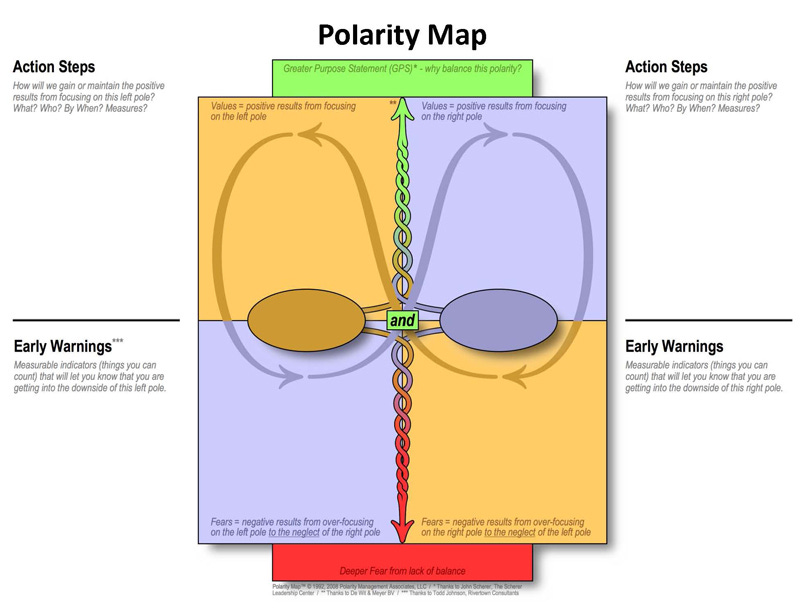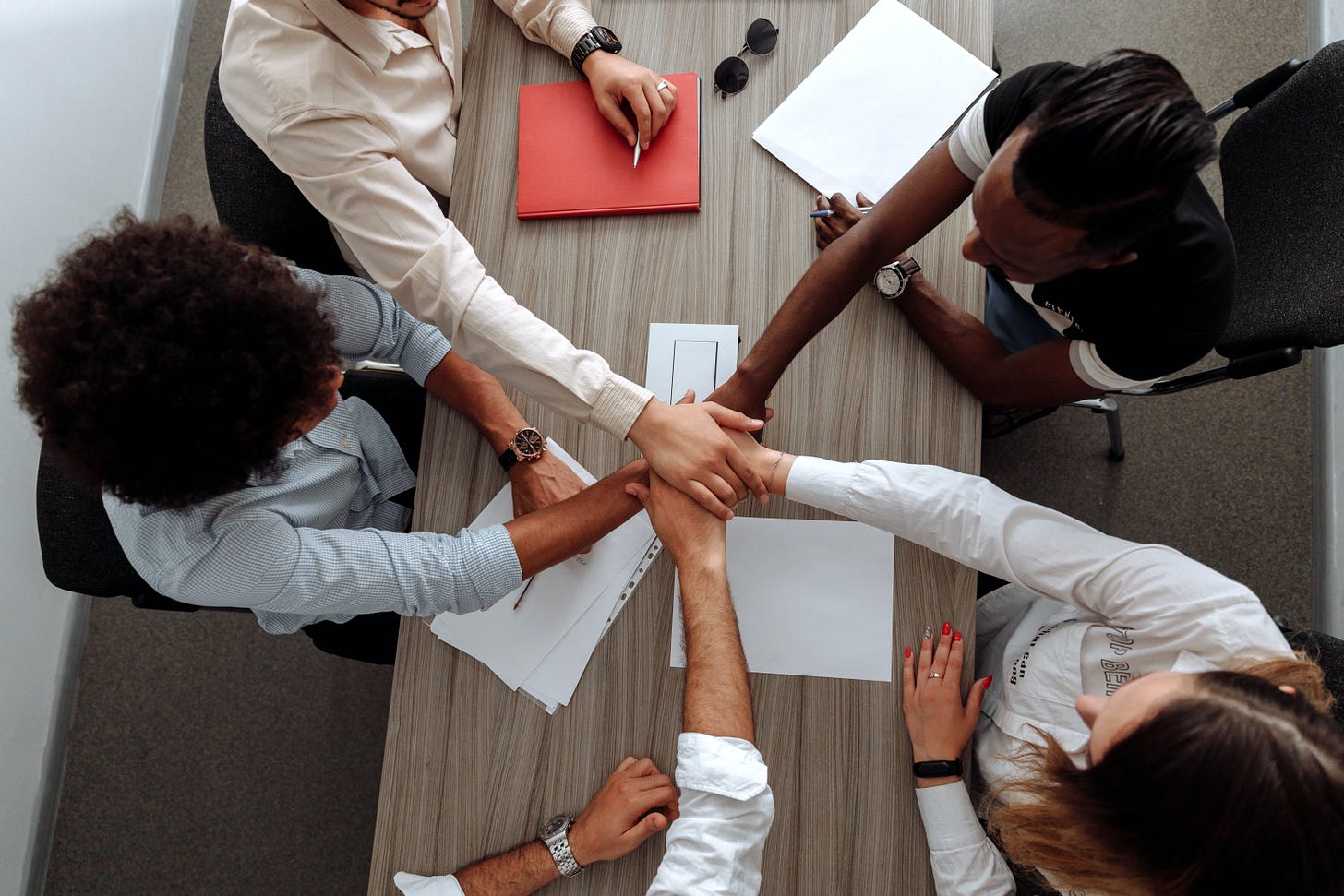In my last essay, I talked about polarities and how we need to know when to solve them or balance them. Interdependent polarities can create magic or conflict, depending on how we deal with them.
Polarity management is the key that ensures magic. It's a tool that comes from Barry Johnson, who wrote an aptly named book called “Polarity Management” in the nineties. Barry has an organization called Polarity Partnerships.
He created a polarity map, a super basic tool that's easy to understand. It's a great tool to use while deliberating with a diverse group of people.
How does a polarity map work?
This is a polarity map, and it’s ideal for a group of people stuck in chronic conflict or polarity. We can use this tool to see how the pieces work together.
First, we need to find out what we want, which sounds easier than it actually is. You're already halfway there if you know what the question is that you're trying to answer. If you can frame the question and the options in ways that everyone can appreciate and get behind the language, you're doing a great job.
What's our goal? What don't we want?
We use a diverse group of people to determine what's best for everyone. From there, we work out two options that fit our needs. Talking about the benefits of both options can be really powerful. It shows the whole group benefits they didn't think about.
Then we talk about the unintended consequences. We could think about this as the shadow side or negative aspects. These consequences arise from over-focusing on one option at the expense of the other.

The old or new way?
Let's think about the fundamental old/new way-of-thinking polarity. A benefit of the old way is that it's reliable and we know it works. Everyone knows how to do it.
But there are unintended consequences of doing things the old way. We stagnate, we become irrelevant, and things don't really happen anymore. It gets really dull, and the energy drains out of the system.
The benefits of the new way are that it's dynamic and exciting. It keeps us on the cutting edge by evolving with our world.
The danger of unintended consequences
Still, the new way has unintended consequences if we forget about the old way. We might make damaging mistakes we've already made if we ignore the past. A lot of interdependent polarities or polarizing questions come down to this.
You can almost think about the left-right divide as fixing what's wrong and trying to devise new options against preserving what's right and what's working.
When we look at our options, we often focus on the elements we don't like. That's where my proposal for option two comes in. However, option two doesn’t solve everything. If we always go down the path of option two, our over-focus on option two will lead to unintended consequences. So, how do we balance this?
How can we mitigate unintended consequences?
Usually, we can solve unintended consequences by going back to the other side and embracing its positive effects. This creates a clever, beautiful infinity symbol.
I find it remarkable that interdependent polarities can solve each other. The benefits of one side usually solve the problems on the other. If we're stagnating because we're doing things the old way, we can fix it by trying a new way, making things dynamic.
If it's too risky to go into a new way of doing things, we can fix that by remembering what we know works. We can stick to our roots. Again, the cycle goes on.
Warning signs
In polarity management, we ask the group to identify the warning signs for the unintended consequences of both options. It's another brainstorming exercise.
Here’s an example warning sign for the old way/new way polarity: People start quitting because they’re disgruntled. Those who have been around for a long time start leaving. That’s a sign that there’s too much of the new way. If everyone ages out, maybe there’s too much of the old way.
The group can map out the action steps, too. So, if we hit the warning sign, how can we lift up the benefits of the other option? Once you've taken a problem and turned it into an object, the group can see it as an interactive, dynamic system.
You can use this to your advantage. You can assign people roles, and they can choose who looks out for that warning sign. There's always going to be someone who wants to do that. Then the group can take on creating a solution for the warning sign.
By objectifying the problem, we become a team in charge of ensuring we don't fall into an undesirable situation.
How do complexity theory and polarity thinking help us?
Complexity theory and polarity thinking are potent tools to guide us through the wicked problems we face in this world.
They have these cool qualities that move us away from simple, one-sided solutions and polarizing approaches. They make us realize that we're part of something bigger. There are a whole bunch of moving parts in our system, and we can’t forget the interdependence of all those different parts.
These tools give us a holistic perspective so we can focus on the value of all the different pieces and how they work together. What's important is the quality of the relationships. If something's not working in a system, often the nature of the relationships or processes are things we need to consider improving.
These approaches also help us recognize that we need diverse perspectives. If we had a system that only wanted to take one side of the polarity, there would no longer be a dynamic adaptive system. It would fall apart and become destructive or degenerative. We must stay in the dynamic process and adapt; we can't just have fixed solutions.
Often, resistance is not the best way of dealing with something. If we don't like something, we need to respond to it adaptively. Trying to deny that an issue is super complex or trying to control it can become a serious problem.
Operating principles can lead the way
A clever strategy is for us to develop simple operating principles that everyone can agree with. Instead of trying to predict everything that might happen, we can create a system where everyone has more or less agreed on the approach. Maybe we’re going to try to be as inclusive or sustainable as possible, or we're going to respond in a particular way to an issue. Those things allow a system to adapt without needing to control the situation or create specific regulations.
Complexity theory and polarity thinking remind us that, while the world is unpredictable, it's predictably unpredictable. We know what we don't know, and that's powerful. We can experiment, make prototypes, and keep making adjustments.
We don't know how to solve wicked problems, but we can try different solutions. We can compare them to each other or blend them. Let's not go all in on something; let's try a slightly different approach before committing to a solution that might not be the answer.
We also can get better at risk management. If we know that we don't know what's going to happen, we can ensure that we've prepared for all the eventualities. That way, we don’t put all our eggs in one basket. Just because something worked before or has been working for a while doesn't mean it will always work.
We must expand the lens of our understanding
If we keep on doing something in the same way, it's probably not going to work. We must be aware of the wider context and conditions. If we're looking at something, but we can't quite figure out what's going on, we need to extend our point of reference.
Perhaps there are some voices we aren't including in the conversation. Maybe we haven’t considered other things that are happening. Knowing where you are and what's happening around you is a great way to get out of polarization with these super complex issues.
It's tricky, but we need to accept unpredictability. In the future, I’ll be writing about how we can develop the capacity to live in ambiguity. Living in a world where we don't know what's going to happen is scary. But there are ways we can deal with that.
So that's something for you to look forward to. In my next essay, there are a bunch of really cool tools and applications of polarity thinking and complexity theory for our system. Stay tuned and subscribe if you haven't already.
If you prefer to watch your content, here’s a video on the topic of this essay:
You can find more information about the work I do in conflict transformation on my website: http://www.omni-win.com
You can schedule a call with me here: https://calendly.com/duncanautrey
Don’t forget to check out the rest of my posts as I discuss how we can work together to ensure we all win.
If you’d like to see more of these posts, subscribe to Omni-Win Visions here on Substack:
It would also be great if you could subscribe to my YouTube channel, where you can watch more of my long-form content, authentic discussions, and weekly content:





